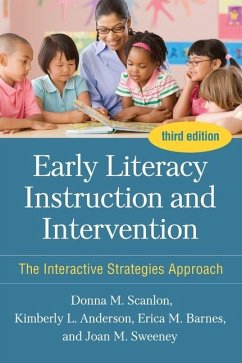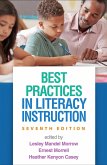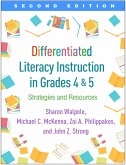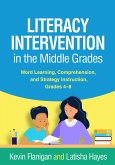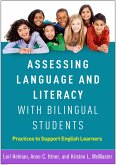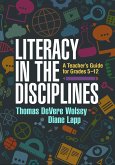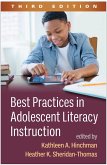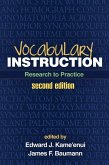Donna M Scanlon, Kimberly L Anderson, Erica M Barnes, Joan M Sweeney
Early Literacy Instruction and Intervention
The Interactive Strategies Approach
Donna M Scanlon, Kimberly L Anderson, Erica M Barnes, Joan M Sweeney
Early Literacy Instruction and Intervention
The Interactive Strategies Approach
- Gebundenes Buch
- Merkliste
- Auf die Merkliste
- Bewerten Bewerten
- Teilen
- Produkt teilen
- Produkterinnerung
- Produkterinnerung
This established text and teacher resource is now in a revised and updated third edition, with a broader focus on whole-class instruction as well as small-group and individualized intervention. It provides an evidence-based framework for supporting literacy development in the primary grades, particularly for students who experience reading difficulties.
Andere Kunden interessierten sich auch für
![Best Practices in Literacy Instruction Best Practices in Literacy Instruction]() Best Practices in Literacy Instruction89,99 €
Best Practices in Literacy Instruction89,99 €![Differentiated Literacy Instruction in Grades 4 and 5 Differentiated Literacy Instruction in Grades 4 and 5]() Sharon WalpoleDifferentiated Literacy Instruction in Grades 4 and 563,99 €
Sharon WalpoleDifferentiated Literacy Instruction in Grades 4 and 563,99 €![Literacy Intervention in the Middle Grades Literacy Intervention in the Middle Grades]() Kevin FlaniganLiteracy Intervention in the Middle Grades65,99 €
Kevin FlaniganLiteracy Intervention in the Middle Grades65,99 €![Assessing Language and Literacy with Bilingual Students Assessing Language and Literacy with Bilingual Students]() Lori HelmanAssessing Language and Literacy with Bilingual Students56,99 €
Lori HelmanAssessing Language and Literacy with Bilingual Students56,99 €![Literacy in the Disciplines Literacy in the Disciplines]() Thomas Devere WolseyLiteracy in the Disciplines82,99 €
Thomas Devere WolseyLiteracy in the Disciplines82,99 €![Best Practices in Adolescent Literacy Instruction Best Practices in Adolescent Literacy Instruction]() Best Practices in Adolescent Literacy Instruction81,99 €
Best Practices in Adolescent Literacy Instruction81,99 €![Vocabulary Instruction Vocabulary Instruction]() Vocabulary Instruction66,99 €
Vocabulary Instruction66,99 €-
-
-
This established text and teacher resource is now in a revised and updated third edition, with a broader focus on whole-class instruction as well as small-group and individualized intervention. It provides an evidence-based framework for supporting literacy development in the primary grades, particularly for students who experience reading difficulties.
Hinweis: Dieser Artikel kann nur an eine deutsche Lieferadresse ausgeliefert werden.
Hinweis: Dieser Artikel kann nur an eine deutsche Lieferadresse ausgeliefert werden.
Produktdetails
- Produktdetails
- Verlag: Guilford Publications
- 3rd edition
- Seitenzahl: 532
- Erscheinungstermin: 29. März 2024
- Englisch
- Abmessung: 254mm x 178mm x 27mm
- ISBN-13: 9781462553662
- ISBN-10: 1462553664
- Artikelnr.: 68917963
- Herstellerkennzeichnung
- Libri GmbH
- Europaallee 1
- 36244 Bad Hersfeld
- gpsr@libri.de
- Verlag: Guilford Publications
- 3rd edition
- Seitenzahl: 532
- Erscheinungstermin: 29. März 2024
- Englisch
- Abmessung: 254mm x 178mm x 27mm
- ISBN-13: 9781462553662
- ISBN-10: 1462553664
- Artikelnr.: 68917963
- Herstellerkennzeichnung
- Libri GmbH
- Europaallee 1
- 36244 Bad Hersfeld
- gpsr@libri.de
Donna M. Scanlon, PhD, is Professor Emeritus in the Department of Literacy Teaching and Learning at the University at Albany, State University of New York, where she served as director of the Child Research and Study Center. Dr. Scanlon has spent most of her career studying children's reading difficulties and helping families and schools address the needs of students who struggle with literacy development. Her research contributed to the emergence of response to intervention as a process for preventing reading difficulties and avoiding inappropriate and inaccurate learning disability classifications. In recent years, her work has focused on the development of teacher knowledge and teaching skill to help prevent reading difficulties in young children and remediate reading difficulties among older children. Dr. Scanlon has served on the Literacy Research Panel, Response to Intervention Task Force, and Response to Intervention Commission of the International Literacy Association. Kimberly L. Anderson, PhD, is Associate Professor in the Department of Literacy Studies, English Education, and History Education at East Carolina University. Her research focuses on improving teacher preparation for early literacy instruction and on the development of literacy tutoring protocols that can be used by tutors with limited expertise. Dr. Anderson contributed to research on the Interactive Strategies Approach (ISA) in her past role as a research associate and director of professional development at the Child Research and Study Center, University at Albany, State University of New York. Dr. Anderson has a particular interest in the role of strategy instruction in word solving and has studied the differential impact of professional development that emphasizes the combination of alphabetic decoding and meaning-based strategies, one of the main tenets of the ISA. Erica M. Barnes, PhD, is Associate Professor in the Department of Literacy Teaching and Learning at the University at Albany, State University of New York. Her research investigates teacher-child interactions in preschool and early elementary classrooms that promote language and literacy growth, with an emphasis on the developmental trajectories of children with varying levels of language abilities from underserved populations. Dr. Barnes is interested in how language facilitates literacy development, and how teachers may differentiate instruction for students to prevent literacy-learning difficulties. She has worked as a special education teacher, a teacher consultant, and a progress-monitoring consultant in K-12 settings. Joan M. Sweeney, MSEd, is a reading specialist in a Capital District public school in New York State. Previously, she was a research associate in the Child Research and Study Center, University at Albany, State University of New York, where she provided intervention for struggling readers, supervised intervention teachers, and coached classroom teachers utilizing the Interactive Strategies Approach to support children's literacy development.
Preface to the Third Edition
Introduction
I. Theoretical and Practical Understandings of Early Literacy Learning and
Instruction
1. Early Literacy Learning and the Interactive Strategies Approach
2. Responsive Instruction
3. Motivation to Read and Write
II. Understanding Print and the English (Alphabetic) Writing System
4. Purposes, Concepts, and Conventions of Print
5. Phonemic Awareness
6. Letter Naming and Letter Formation
7. Letter-Sound (Grapheme-Phoneme) Relationships
8. The Alphabetic Principle and the Alphabetic Code: Early Development
9. Rimes and Word Families
10. The Alphabetic Principle and the Alphabetic Code: Later Development
11. Morphological Units and Multisyllabic Words
III. Word Learning
12. Strategic Word Solving, Word Identification, and Word Learning
13. High-Frequency Word Learning and Word Identification
IV. Meaning Construction
14. Text-Reading Fluency
15. Vocabulary and Oral Language Development
16. Comprehension and General Knowledge
V. Integration of the Goals: Putting It All Together
17. Small-Group Instruction
18. Revisiting and Concluding
Glossary
References
Index
Introduction
I. Theoretical and Practical Understandings of Early Literacy Learning and
Instruction
1. Early Literacy Learning and the Interactive Strategies Approach
2. Responsive Instruction
3. Motivation to Read and Write
II. Understanding Print and the English (Alphabetic) Writing System
4. Purposes, Concepts, and Conventions of Print
5. Phonemic Awareness
6. Letter Naming and Letter Formation
7. Letter-Sound (Grapheme-Phoneme) Relationships
8. The Alphabetic Principle and the Alphabetic Code: Early Development
9. Rimes and Word Families
10. The Alphabetic Principle and the Alphabetic Code: Later Development
11. Morphological Units and Multisyllabic Words
III. Word Learning
12. Strategic Word Solving, Word Identification, and Word Learning
13. High-Frequency Word Learning and Word Identification
IV. Meaning Construction
14. Text-Reading Fluency
15. Vocabulary and Oral Language Development
16. Comprehension and General Knowledge
V. Integration of the Goals: Putting It All Together
17. Small-Group Instruction
18. Revisiting and Concluding
Glossary
References
Index
Preface to the Third Edition
Introduction
I. Theoretical and Practical Understandings of Early Literacy Learning and
Instruction
1. Early Literacy Learning and the Interactive Strategies Approach
2. Responsive Instruction
3. Motivation to Read and Write
II. Understanding Print and the English (Alphabetic) Writing System
4. Purposes, Concepts, and Conventions of Print
5. Phonemic Awareness
6. Letter Naming and Letter Formation
7. Letter-Sound (Grapheme-Phoneme) Relationships
8. The Alphabetic Principle and the Alphabetic Code: Early Development
9. Rimes and Word Families
10. The Alphabetic Principle and the Alphabetic Code: Later Development
11. Morphological Units and Multisyllabic Words
III. Word Learning
12. Strategic Word Solving, Word Identification, and Word Learning
13. High-Frequency Word Learning and Word Identification
IV. Meaning Construction
14. Text-Reading Fluency
15. Vocabulary and Oral Language Development
16. Comprehension and General Knowledge
V. Integration of the Goals: Putting It All Together
17. Small-Group Instruction
18. Revisiting and Concluding
Glossary
References
Index
Introduction
I. Theoretical and Practical Understandings of Early Literacy Learning and
Instruction
1. Early Literacy Learning and the Interactive Strategies Approach
2. Responsive Instruction
3. Motivation to Read and Write
II. Understanding Print and the English (Alphabetic) Writing System
4. Purposes, Concepts, and Conventions of Print
5. Phonemic Awareness
6. Letter Naming and Letter Formation
7. Letter-Sound (Grapheme-Phoneme) Relationships
8. The Alphabetic Principle and the Alphabetic Code: Early Development
9. Rimes and Word Families
10. The Alphabetic Principle and the Alphabetic Code: Later Development
11. Morphological Units and Multisyllabic Words
III. Word Learning
12. Strategic Word Solving, Word Identification, and Word Learning
13. High-Frequency Word Learning and Word Identification
IV. Meaning Construction
14. Text-Reading Fluency
15. Vocabulary and Oral Language Development
16. Comprehension and General Knowledge
V. Integration of the Goals: Putting It All Together
17. Small-Group Instruction
18. Revisiting and Concluding
Glossary
References
Index

